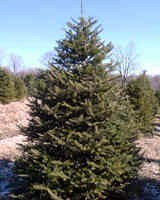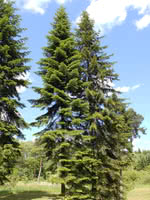Mon-Fri 9am - 5pm Mountain time
Canaan Fir vs Siberian Fir
Abies balsamea phanerolepis
Abies sibirica
CUSTOM GROW
COMING SOON
(new stock expected: later this season)
Canaan Fir, which is closely related to Balsam Fir, is known for its open-growing patterns and strong branches.
Canaan Fir is highly adaptable to many soil conditions and thrives in both shaded areas or direct sunlight. It is commonly used for Christmas tree farming or reforestation.
This rugged landscape tree remains green year-round.
Siberian Fir is an evergreen tree best known for its strong aroma. This tree's needles are popular for essential oils and aromatherapy. It also grows softwood that is used for furniture and wood pulp. This species is very cold hardy and shade tolerant.
This species is bright green and conical shaped. Most interesting is its upright blue cones that fade into brown as they mature.
Canaan Fir Quick Facts
Siberian Fir Quick Facts
In row spacing: 3 m (10 ft)

